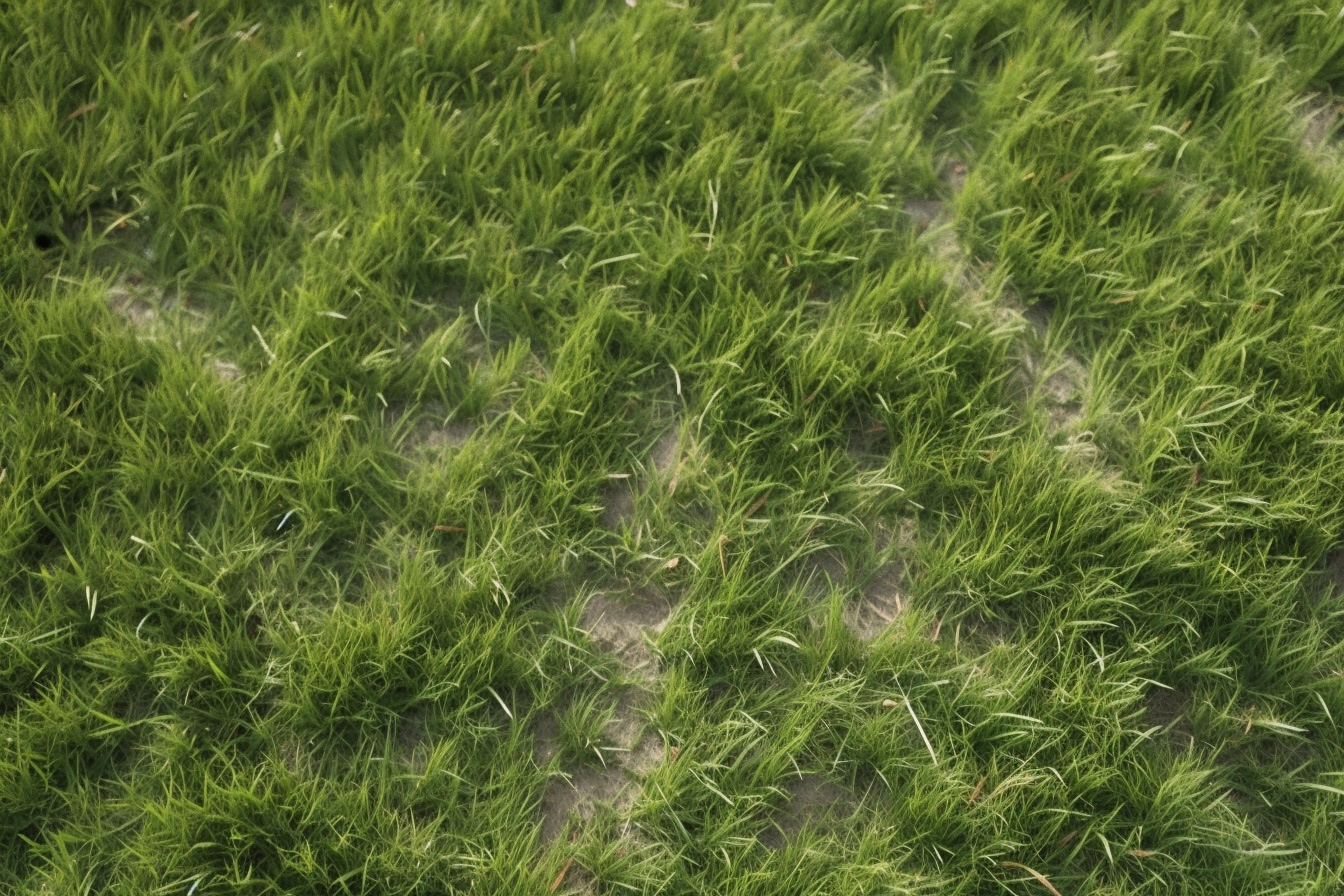A lush, green lawn can be the pride of any homeowner, but sometimes new grass can grow thin and patchy. This can cause frustration as you take care of your lawn, wondering what went wrong. The phrase “lawn is thin” refers to a situation where the grass on a lawn appears to be sparse and lacking in thickness. When describing a lawn as thin, it implies that the grass coverage is not as full or lush as desired or expected.
Table of Contents
ToggleGrass thinning is commonly caused by factors like inadequate sunlight, poor soil health, improper watering, or heavy foot traffic. To improve thin grass, consider increasing sunlight exposure, fertilizing regularly, watering deeply and infrequently, and limiting foot traffic.
This can occur due to various factors, such as inadequate watering, lack of proper fertilization, or excessive foot traffic. A thin lawn may also result from disease or pest infestation, which can further contribute to the deterioration of its overall health and appearance. To improve the condition of a thin lawn you might need to work on aerating the soil, overseeding with suitable grass varieties, applying fertilizers, and ensuring proper irrigation.
Looking at the possible causes of thin new grass growth can help you effectively address the issue and promote a healthier, more robust lawn. The key is to strike a balance between providing the right amount of nutrients, water, and sunlight, and utilizing proper mowing and maintenance techniques. Selecting the appropriate grass type for your specific region can also have a significant impact on overall lawn density.
Key Takeaways
- Proper watering, fertilization, and mowing techniques are essential for a healthy, dense lawn.
- Disease and pest control can help prevent thin grass growth.
- Choosing the right grass type for your region will improve the overall success and appearance of your lawn.
Causes of Thin Grass
Lack of Sunlight
New grass requires plenty of sun to grow thick and healthy. If your lawn is surrounded by buildings, tall trees, or located in a generally shady area, this might be the reason for the thin appearance of your grass. Inadequate sunlight can lead to weak and slow growth, as well as increased susceptibility to diseases and pests. To combat this issue, consider removing overhanging branches or trimming neighboring foliage to provide more sunlight for your lawn.
Poor Seeding
One possible reason for your grass being thin is improper seeding. When seeds are not evenly distributed or are too sparse, grass will grow in patches with thin and bare areas. It is essential to ensure that your lawn is properly seeded during spring to promote even germination and growth. You can achieve this by following the seeding instructions on your preferred grass seed brand and using the recommended amount of seed based on your lawn’s size.
Compacted Soil
Compacted soil can significantly affect grass growth. Soil compaction occurs over time due to factors such as heavy foot traffic, pets, and heavy machinery. When the soil becomes hard and compacted, it restricts the roots’ ability to access water, nutrients, and oxygen, which will result in thin grass growth. To remedy this issue, you can use aeration methods, such as a power core aerator, to loosen up the soil and allow water, nutrients, and air to reach the grass roots better.
Thatch Buildup
Thatch is a layer of dead grass, roots, and other organic matter that accumulates on the soil surface and can cause your grass to appear thin. Excessive thatch buildup can prevent water and nutrients from reaching the grass roots, leading to weakened plants and eventually thinning grass. Regular dethatching can help alleviate this issue and keep your lawn looking its best.
Drought
Grass requires consistent moisture to grow properly. In areas where lack of water is an issue, due to climate, the environment, or even water restrictions, your grass may struggle and become thin. To help maintain a thick and healthy lawn, ensure your grass receives enough water (either naturally or by supplementing with irrigation) according to its specific needs. If water is scarce, consider using drought-tolerant grass varieties or other landscaping options to conserve water while maintaining a healthy outdoor space.

Watering and Irrigation
Overwatering and Underwatering
Overwatering and underwatering both contribute to thin grass. When new grass receives too much water, it can lead to shallow root development, making the grass more susceptible to environmental stress. On the other hand, insufficient watering can weaken grass and slow its growth. To strike a balance, water your lawn with up to 1/2 inch for thin lawns and 1/4 inch for bare soil. It’s best to water your lawn in shorter periods, around 15 minutes at a time, three times a week depending on precipitation. If you’re unsure if your lawn needs water, try the NRCS test: if grass doesn’t spring back after being stepped on, it’s probably time to irrigate3.
Irrigation Systems
An effective irrigation system ensures that your grass receives the right amount of water. Slow-release irrigation systems, like drip lines, help conserve water and promote deep root growth. To maintain a healthy lawn, monitor weather conditions and adjust your watering schedule accordingly3. When it rains for several days, water less, while a succession of hot, dry days means it’s time to water more3. Early morning watering is optimal, as it reduces water loss due to evaporation.
Fertilization Best Practices
Choosing the Right Fertilizer
It’s essential to choose the right fertilizer to ensure your new grass grows thick and strong. Consider the specific needs of your lawn and select a fertilizer that provides essential nutrients like nitrogen, phosphorus, and potassium. Keep in mind that specific grass types, such as perennial rye, may require different nutrients to grow dense and healthy. Moreover, it’s crucial to maintain a proper pH balance to prevent issues like weeds and fungi.
When selecting a fertilizer, also consider amendments that can help boost your lawn’s health. These include ingredients to improve drainage, organic material to feed microorganisms, and elements that balance your soil’s pH level. By carefully selecting a fertilizer, you’re setting your new grass up for success.
Fertilizing Frequency and Timing
Fertilizing at the correct time is crucial for the growth of your new grass. Generally, you should wait 4-6 weeks after your grass has germinated to apply the first layer of fertilizer, as doing so too early can cause damage or hinder growth. For optimal results, choose a slow-release nitrogen fertilizer or a coated granular product with controlled nitrogen release.
It’s also essential to consider the time of year that you fertilize your new grass. Many fertilizers are formulated for specific regions and seasons, so be sure to pick one that aligns with your location and the current time of year.
Starter Fertilizer for New Lawns
Incorporating a starter fertilizer when planting your new grass can provide crucial nutrients to help your lawn establish strong roots and grow densely. A starter fertilizer typically contains a higher percentage of phosphorus compared to standard fertilizers, promoting root development and growth.
Keep in mind that you must carefully follow the recommended application rates to avoid overfertilizing, which can lead to problems like excessive growth, nutrient imbalances, and even burnt grass.
By implementing these best practices in fertilization, you’re well on your way to a lush and thriving lawn.
Mowing and Lawn Maintenance
Proper Mowing Height
To maintain a healthy and thick new grass, it is important to mow at the correct height. A proper mowing height helps to control weeds and promote healthy root development. Generally, you should avoid cutting more than one-third of the grass blade at a time. For most grass types, maintain a grass height of 2.5 to 3 inches. Mowing the lawn too short makes it prone to weed invasion and may cause your new grass to appear thin. If you’re uncertain of the ideal mowing height for your specific grass type, consult a local lawn care expert.
When to Start Mowing New Grass
Patience is crucial when it comes to mowing newly planted grass. You must give your new grass enough time to establish strong roots before subjecting it to foot traffic and the weight of a lawn mower. Typically, you should wait until the new grass reaches a height of 3 to 4 inches before mowing for the first time. This will usually take around 4 to 6 weeks after planting, depending on the grass type and environmental conditions.
When mowing for the first time, be gentle and avoid using a riding lawn mower, as it may be too heavy and damage the young grass. Instead, opt for a lightweight push mower to prevent damage to the delicate roots. After the initial mowing, maintain your lawn by following the proper mowing height guidelines discussed above.
By mowing at the appropriate height and giving your new grass time to establish strong roots, you’ll help promote a thicker, healthier lawn over time.

Disease and Pest Control
Preventing Damage from Insects and Grubs
Insects and grubs, like chinch bugs, can cause damage to your new grass, resulting in a thin lawn. To prevent damage, you should monitor your lawn regularly for signs of pest activity, such as brown spots, wilting grass or increased bird presence. Implement a selective insecticide treatment if necessary, but use it carefully and according to the product label to avoid harming beneficial insects.
Another preventive strategy is maintaining a healthy lawn through proper watering, mowing and fertilization. Healthy grass is less susceptible to pest damage, and it can recover more quickly from any damage that does occur.
Managing Lawn Diseases
Various diseases, such as powdery mildew, can also cause your new grass to appear thin. Powdery mildew, for example, is a fungus that creates a fine white film (called mycelium) on the grass blades, eventually causing them to yellow, then turn brown and thin out. You can learn more about powdery mildew here.
To manage lawn diseases, follow these steps:
- Familiarize yourself with common lawn diseases. Know the symptoms and conditions in which each disease thrives. This will help you quickly diagnose and treat issues.
- Regularly inspect your lawn. Perform routine checkups to detect unusual growth patterns, discoloration or patches.
- Maintain appropriate lawn care. Proper watering, fertilization and mowing are essential in minimizing the conditions that favor disease development. For example, avoid watering in the evening, as this will leave the lawn damp overnight, creating an ideal environment for fungal diseases.
- Use fungicides only when necessary. If a disease cannot be managed by changing lawn care practices, consider applying a fungicide according to the product label.
Dealing with pests and diseases in a timely manner will help your new grass grow thicker and healthier, resulting in a lush, green lawn.
Selecting the Right Grass Type
When it comes to achieving a thick, healthy lawn, selecting the right grass type is crucial. In this section, we’ll discuss how to choose the best grass based on your climate and the varieties that promote dense growth.
Choosing Grass Based on Climate
It’s essential to pick a grass variety that thrives in your specific climate. Grasses are typically divided into two categories: cool-season and warm-season grasses.
Cool-season grasses, such as Kentucky bluegrass, tall fescue, and perennial ryegrass, are well-suited for colder regions. These grasses grow best in temperatures between 60-75°F and tend to remain green throughout the year.
On the other hand, warm-season grasses like Zoysia grass and St. Augustine are better adapted to hotter regions. They flourish in temperatures between 80-95°F and may become dormant and brown during the colder months.
Best Grass Varieties for Dense Growth
Some grasses naturally grow thicker and denser than others, making them an excellent choice if you want a lush lawn. Here are a few top-performing varieties:
- Kentucky bluegrass: Known for its rich blue-green color and fine texture, Kentucky bluegrass creates a dense and attractive turf when properly maintained. It grows best in full sun but can tolerate some shade.
- Zoysia grass: Zoysia is a warm-season grass that creates a thick, carpet-like lawn that is highly resistant to damage from foot traffic. It establishes slowly but requires minimal maintenance once established.
- Tall fescue: This cool-season grass boasts excellent heat and drought tolerance, making it a great choice for a low-maintenance lawn. It forms a dense turf with a deep root system, allowing it to survive harsh conditions.
- Perennial ryegrass: Known for its rapid germination and establishment, perennial ryegrass creates a dense, fine-textured lawn. It is often used in mixtures with other grasses to improve the overall density and wear resistance of the turf.
Remember, selecting the right grass type for your new lawn plays a significant role in its overall health, appearance, and density. Take your climate into account and consider the growth habits of various grass varieties to ensure a thick, beautiful lawn that meets your expectations.
Improving Lawn Density
A thinning lawn can be frustrating to deal with, but there are several techniques to help improve its density. In this section, we will discuss overseeding techniques, aerating and decompacting soil, and reseeding patchy areas to improve the thickness and overall health of your lawn.
Overseeding Techniques
Overseeding is the process of adding new grass seed to your existing lawn to create a thicker appearance and improve overall growth. It’s essential to choose the right grass seed for your lawn’s specific needs and to apply it during the optimal growing season for the best results.
- Begin by mowing your lawn to a shorter height than usual to allow the seeds to penetrate the soil and reach the roots.
- Use a powder rake to spread the grass seed evenly across your lawn. This will ensure optimal seed-to-soil contact.
- Water your lawn after overseeding to help the seeds settle and establish roots.
Aerating and Decompacting Soil
Compacted soil can prevent your lawn’s roots from expanding, leading to thin grass growth. Aerating your lawn can help alleviate compaction and improve the overall health of your grass. This process involves removing small soil plugs from your lawn to create space for air, water, and nutrients to penetrate deeper into the root system.
- Rent or purchase a lawn aerator, and use it to create evenly spaced holes throughout your lawn.
- Dispose of the removed soil plugs or leave them on your lawn to decompose and add nutrients back to the soil.
- Water your lawn after aerating to encourage the penetration of water and nutrients into the root system.
Reseeding Patchy Areas
Bare or patchy areas in your lawn can be an eyesore and can contribute to a thinner appearance. Reseeding these areas can help create a more uniform and dense lawn.
- Prepare the soil in the patchy area by gently raking it to remove any debris, thatch, or dead grass.
- Apply grass seed to the area, being sure to use the appropriate type for your lawn’s needs.
- Gently rake the seeds into the soil, covering them with a thin layer of soil or mulch to promote germination.
- Water the reseeded area regularly to support seed germination and establishment.
By utilizing these techniques and paying close attention to your lawn’s needs, you can improve the density and appearance of your grass, creating a healthier, more vibrant lawn.
Frequently Asked Questions
How can I improve my thin lawn?
To improve your thin lawn, start by aerating the soil using a power core aerator to loosen compacted soil and break up thatch. Make sure to regularly feed your lawn with appropriate fertilizers and ensure it receives sufficient sunlight and water.
What causes new grass to grow thinly?
New grass may grow thinly due to various factors such as lack of fertilizer, hard or compacted soil, excessive shade, and disease or insect issues. Proper lawn care routines can help to address these issues and promote thick, healthy grass growth.
Are there specific products to help thicken a lawn?
Yes, there are specific products designed to help thicken a lawn. For example, use a starter lawn fertilizer when planting new grass, and after 6-8 weeks, feed the lawn with a standard lawn food, like Scotts® Turf Builder® Lawn Food. Regular feedings every 6-8 weeks will provide nutrients necessary to crowd out weeds and promote thick growth.
- Scotts Turf Builder Lawn Food is a fertilizer that feeds and strengthens grass to help protect against future problems
- Fertilizer builds strong, deep roots and improves the lawn’s ability to absorb water and nutrients (vs. unfed lawn)
- Apply this grass fertilizer to a wet or dry lawn
- This lawn care product can be used on any grass type
- One 37.5 lb. bag of Scotts Turf Builder Lawn Food covers 15,000 sq. ft.
Does watering frequency affect grass thickness?
Watering frequency does play a role in grass thickness. Proper watering is essential for establishing a healthy, thick lawn. Over-watering or under-watering can lead to thinning and other detrimental issues. It is generally recommended to water your lawn deeply and infrequently, ensuring it receives about 1-1.5 inches of water per week.
What grass types are prone to thin growth?
Some grass types may be more prone to thin growth due to their specific characteristics and requirements. For instance, fine fescue grasses are typically more shade-tolerant but may produce thinner lawns in direct sunlight. Warm-season grasses like Bermuda grass can also appear thinner if they are not receiving enough sunlight or proper nutrients.
How long does it typically take for new grass to thicken?
The time it takes for new grass to thicken can vary depending on factors like grass type, soil conditions, and maintenance practices. Generally, with proper care and favorable conditions, new grass should start to thicken within a few weeks to a couple of months. Patience and diligent lawn care are key to achieving a lush, thick lawn.










